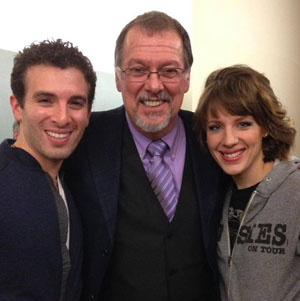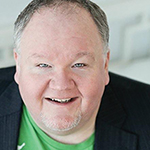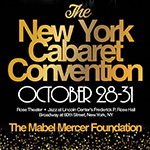Eric Michael Gillett
The Journey Begins
March 11, 2015

At the end of Winter 1995, Darrell Henline, the founder and original publisher of Cabaret Scenes, made Peter Leavy an offer Leavy eventually could not refuse. Henline was planning the second issue of the magazine and he gave Leavy carte blanche to submit a piece on any subject he wished so long as it was on cabaret. Leavy chose to write a short feature on Eric Michael Gillett, one of our favorite cabaret performers. Over the years we followed him at the Cabaret Convention, at his various shows, at Montclair State where he starred in La Cage aux Folles and on Broadway when he played in a revival of Kiss Me, Kate. In May of

with Michael Ricciardone and Jeff Riebe
this year, Eric will be one of the few male singers to appear — with his Lorenz Hart show — at Cabaret at the Music Room at The Caramoor Center for Music and the Arts. The annual, elegant evening, complete with champagne, dessert, and coffee after the performance, is underwritten by Adela and Lawrence Elow. Eric has been frequently reviewed in CS, but an up-to-date feature is too-long overdue and his planned appearance at Caramoor on May 9 seems just the right time to reconnect with him. It is said that time flies when you are having fun and Eric always provides fun, such as at his recent Noël Coward show. It was a performance that revealed that Eric is not only a consummate singer and actor, but a compelling storyteller. Now that CS has decided it is time again to learn more about Eric Michael Gillett, whose place in cabaret has continued to grow beyond performing, we have decided to let him tell his own story, going back to the beginning of his career. In our May/June issue, we will focus on his most recent activities.
By Eric Michael Gillett as told to Barbara Leavy.
In high school, singing and acting were never my goals. My school had no performing arts department so my initial forays into public performance were strictly through competitive speech, with which I was involved in both high school and college. My intentions early on were always to pursue a career as a teacher and as a speech pathologist. I had a minor speech impediment when I was young and, fortunately, our school district had the funds to provide regular speech therapy sessions. My therapist was caring and diligent, and she gave me a true appreciation for clearly enunciated speech and correct voice placement. Along with her efforts and those of two fantastic grammar school teachers I had back in 3rd grade and 5th grade respectively, I fell in love with the idea of teaching as a profession.
As it tends to happen, life intervened. In high school and college I had some negative experiences with some teachers and counselors that left a bad taste in my mouth. It wasn’t just things that were done to me but, in fact, behavior they demonstrated in dealing with other students that gave me a growing concern that I might be another of the kind of teacher who negatively impacts on a developing mind and talent. To this day, I am aware of my effect on performers I am coaching or directing.

Because I got involved with theater at college, I began to pursue outside performing opportunities and…well, the rest is history. It turns out that, all these years later, I have never, since I became a professional, had to take a “civilian” job outside of the entertainment industry. In fact, just as a side note, the one time I was contracted to play a waiter on a project, I was completely clueless and had to be sent to waiter school in order to figure out how to initiate any practical activity within my scenes. And that teacher told me, “Thank God you’re an actor. You’d be a disaster on the floor or in the kitchen.”

in Bal du Moulin Rouge Las Vegas Hilton
Quick overview: I grew up and trained in Los Angeles, found a brilliant voice teacher named Jan Ritschel (with whom I had an ongoing 40-year relationship until she passed a couple of years ago), and did most of my early performing in dinner theaters there. There followed a series of long-term performing jobs, including Hallelujah Hollywood (two years), Bal du Moulin Rouge (two-and-a-half years), and Ringling Bros. and Barnum & Bailey Circus (11 years, with a return for several weeks the season after I finally left the show and committed to a life in New York). In between, I got my Equity card, thanks to Teri Ralston, in a production of Side by Side by Sondheim with Peggy Lee, worked with the legendary Jan Clayton in a Buddy Ebsen-produced musical, Turn to the Right, and got to work with stars like Juliet Prowse, Debbie Reynolds, Charo, Jim Nabors and Suzanne Somers. And, along the way, during those Las Vegas years, I started teaching my first acting classes.
When I finally made the move to New York, I was already involved in the world of cabaret, but my focus was on fulfilling a career-long dream of doing a Broadway show. I was fortunate enough to have Vinnie Liff, Tara Rubin and Paul Gemignani take me under their collective wings and place me in the original cast of the revival of Kiss Me, Kate. That was followed by what I think of as my “Broadway years,” with Sweet Smell of Success and The Frogs coming on the heels of the glorious Kiss Me, Kate experience. I suppose, the recent story you’re seeking starts somewhere in that last period, backstage at The Frogs. My friend, a fierce actress/dancer named Francesca Harper, asked me to coach her on a Broadway audition. The coaching went so well that she brought me the sides for another upcoming Broadway audition. She got callbacks for both and, eventually, booked both jobs, putting herself in the enviable position of having to choose between two brand-new Broadway shows. Francesca recommended me to others and, bit by bit, I began coaching on a regular basis.
Around the same time, a wonderful singer named Culver Casson approached me about directing a cabaret show for her. It was called Island Magic and, though we took our title from the name of the movie in the Bernstein song from Trouble in Tahiti, the show was actually about this magical kingdom we call Manhattan. It was a joyous experience on every level and, for the first time, between coaching and directing, I felt a need to grow beyond the limitations of performing and move into other creative waters.
When Peter interviewed me back in the ’90s (when dinosaurs ruled the earth!), I was still “just” a performer. If memory serves, my day job was still being Ringmaster for Ringling Bros. and Barnum & Bailey Circus and I was flying in to NYC on my days off to do cabaret shows. The circus gig gave me a certain notoriety that, in fact, opened a lot of doors but, also, closed off a lot of opportunities. Even today, the “ringmaster” tag leads some to believe that I have a “booming baritone” and believe in the “big delivery.”

Leaving the circus family, and it is a family, and striking out on my own to see what I might be able to do in the Big Bad Apple was thrilling, frightening, inspiring, dispiriting, deflating and energizing, all at the same time. And choosing New York City as my home changed my life. For one thing, it was the first time I had ever been anyplace where people talked as quickly as I do.
Like a lot of stage performers, I hoped to make it to Broadway. But, when I first moved here, the bigger gift was the ability to immerse myself in cabaret in ways that were not possible when I was on the road year-in and year-out. I got to experience the club scene in a way I could never have done from the circus train. What I discovered along the way, and by watching the greats like Margaret Whiting, Julie Wilson, Mary Cleere Haran, Steve Ross and so many others, was that there were a million ways to approach an act and a million stories to be told. The possibilities were limitless. As much as I loved theater, no matter how large the role, the satisfactions of gathering a group of people into an intimate space and asking them, as my colleague Barry Kleinbort likes to say, “to pay attention…plus a two-drink minimum,” were infinitely greater.

And so, I sort of meandered down my little path, moving from Broadway and Kiss Me, Kate to off-Broadway and Time and Again and back to Broadway with Sweet Smell of Success, all the while building new shows on a regular basis but still feeling, somehow, that I wasn’t expressing what was in me.
The turning point for me was a song by Larry Gatlin called “I’ve Done Enough Dyin’ Today.” I had heard it on the radio during my circus travels in the deep South while driving from one small town in Alabama to another in Mississippi. The song got under my skin, the way Craig Carnelia’s “Flight” had several years earlier. I just couldn’t bring myself to do yet another cabaret show unless I could find an organic way to include the Gatlin song, but I couldn’t wrap my head around what story I could tell that would include it. The inspiration, finally, came from the radio.
I started thinking back to my first radio, a red transistor that my grandfather had gotten me with Green Stamps (remember those?) and on which I would listen to Frankie Valli sing “Sherry” in that high falsetto. Later it was Denny Doherty of The Mamas and the Papas. (By the time I was 17, I was doing a pretty great job of imitating Denny singing “California Dreamin’,” a feat which stood me in good stead here in NY when I became his alternate in the Off-Broadway show, Dream a Little Dream.) Thinking about that radio made me start listing all the great moments in my life that were connected to a sort-of soundtrack of songs that were playing on the radio when the moments happened. And out of that, I realized I could tell, not necessarily my own biographical story, but a 30-year history of American pop music, personalized by my own memories of the context in which I had heard the songs themselves.
That was the show that, quite literally, changed my life. From that time on, I have never built a show for myself that didn’t involve some sort of itch I couldn’t scratch, some story I felt I had to get off my chest. And it was that point of view that led me to my first cabaret directing jobs with Culver Casson (Island Magic), Ron Ramsay (Go with Me), Valerie Lemon (With a Song in My Heart) and Rita Harvey. My first question of a potential client was always, “Why do you want to do this?” and, unless the answer was something on the order of “I have to tell this story or I’ll burst,” I simply didn’t take on the project.

Photo: Russ Weatherford
In a directing career, as in so many things in life, timing and opportunity is everything. Valerie Lemon parted ways with her original musical director, which brought us to Don Rebic, my musical brother. Don, in turn, brought me to Karen Akers, the most remarkable singing actress I have ever encountered. Directing for Karen, especially when our first effort Simply Styne was a major seller at the Oak Room, brought me to the attention of several more of the artists with whom I’ve had the pleasure of collaborating over the years, including Lari White, Sheera Ben-David, Karen Oberlin, Marieann Meringolo and so many others. But the big moment, at least for me, came with the chance to collaborate with, quite literally, my oldest friend in show business, KT Sullivan, on Autumn in New York, a show she still tours to this day, though under the title Colored Lights.
You see, unlike any other artist with whom I had worked, KT and I had real history. We’ve known each other for what seems like forever, all the way back to our days in Los Angeles when she quite literally made the phone call that got me the singing job that kept me from having to find what would have been my first and only real office or waiter work. When she came to me to discuss working together, I told her it would be an honor and a pleasure, but that I had one condition: i.e., that she had to let me help her bring out the many facets of her personality and voice I felt had started to take a back-seat to the frothy, girly and, for lack of a better term, whipped-cream dessert qualities at which she so excels. Once and for all, I wanted the major critics to see her as a full meal, with her comedy leavened by anger, fear, frustration, hunger, hope and womanly joy. I wanted to see the WOMAN I know standing up there singing, in all her glory.

Thank God she trusted me enough to do this work with her. Of all the shows I’ve ever directed, and of all the artists, there are more “moments” in the evenings I helped build for KT to which I point with pride and humility than with any other artist: Her breathtaking “And I Was Beautiful,” not to mention her “One Hallowe’en.” Her heartbreaking “Ol’ Man River,” which everyone wanted to cut from the show until the Times singled it out as the piece of high art it was. I could go on and on. But it all began with telling her to sing, against her better judgement, a bit of “Much More” in Autumn in New York. I remember KT saying the song was far too young for her and we parried back and forth until I pointed out to her that, as important an artist as she had become on the cabaret scene, she still hungered for the legitimate stage. That hunger, I felt, was universal and not restricted to a young girl fantasizing as Luisa does in The Fantasticks. KT’s performance was chilling.

Those wonderful ladies truly gave me my “street cred” and have led me to unbelievable opportunities with artists like Tovah Feldshuh, who allowed me to assist her in tailoring her show for its 54 Below debut, and young artists from Broadway who are crossing over into cabaret and concerts, like Jarrod Spector (Jersey Boys, Beautiful), Mandy Gonzalez (In the Heights, Wicked, Dance of the Vampires) and, most recently, Jessie Mueller (Beautiful, On a Clear Day…), whose duo show with Jarrod should have just gone out on its maiden voyage by the time this article goes to press.

Some Career Highlight since Peter interviewed me.
–Principal soloist at New York City Opera in Candide and Cinderella, as well as standby for Maj. General Stanley in The Pirates of Penzance.
–Playing Patti LuPone’s father in my New York City Ballet debut, Seven Deadly Sins.
–The run of Careless Rhapsody: The Lyrics of Lorenz Hart, which played at 54 Below and will also be the show in which I make my debut at Caramoor on May 9, 2015.
–MAC Awards for Outstanding Vocalist, Major Artist-Male, Outstanding Director (twice), and Special Production.
–First recipient of the Spirit Award, from Help Is on the Way Today.
–Recipient of the Dick Gallagher Award, bestowed by the Mabel Mercer Foundation at Rose Hall.





